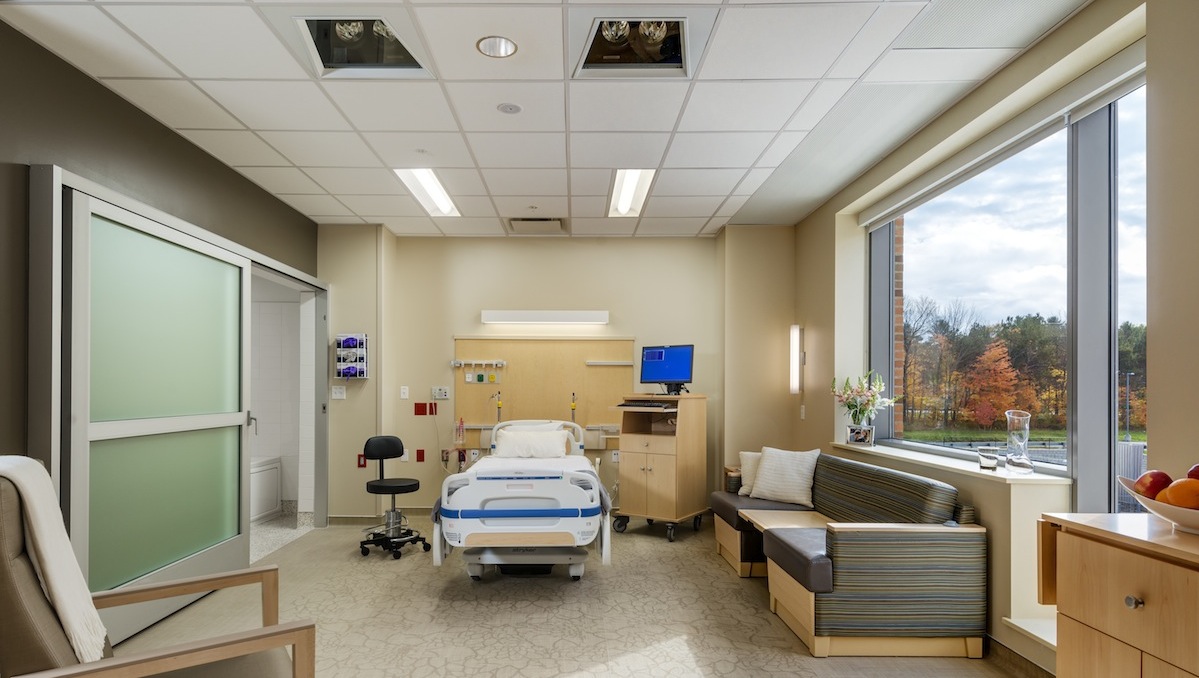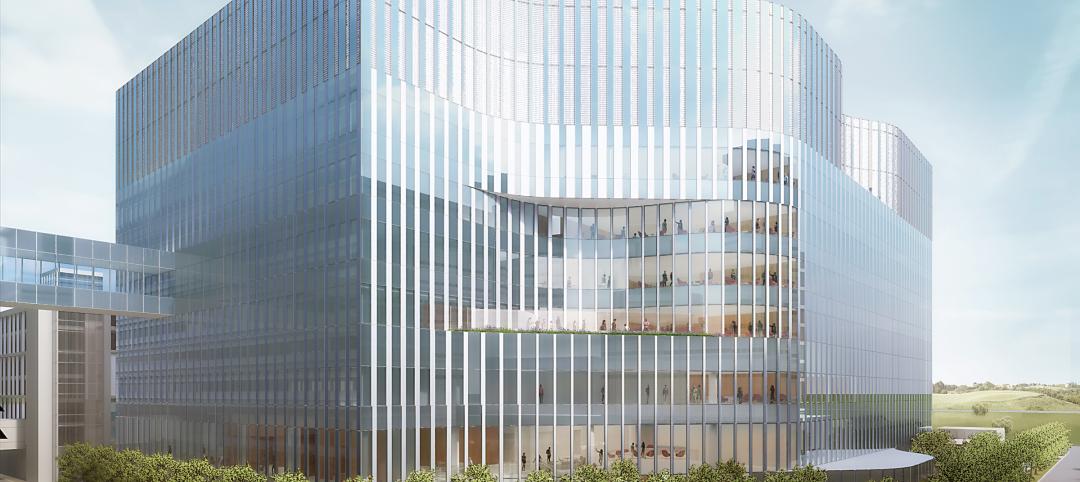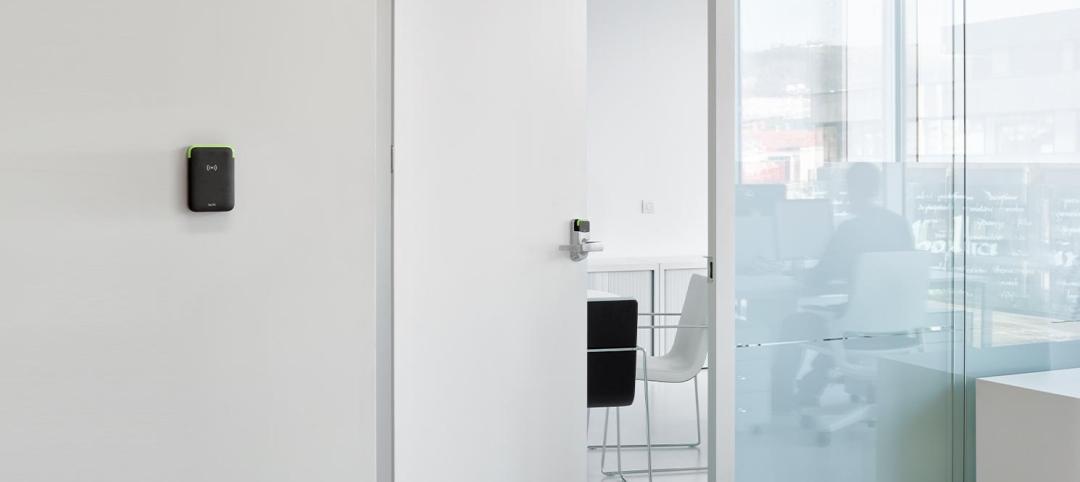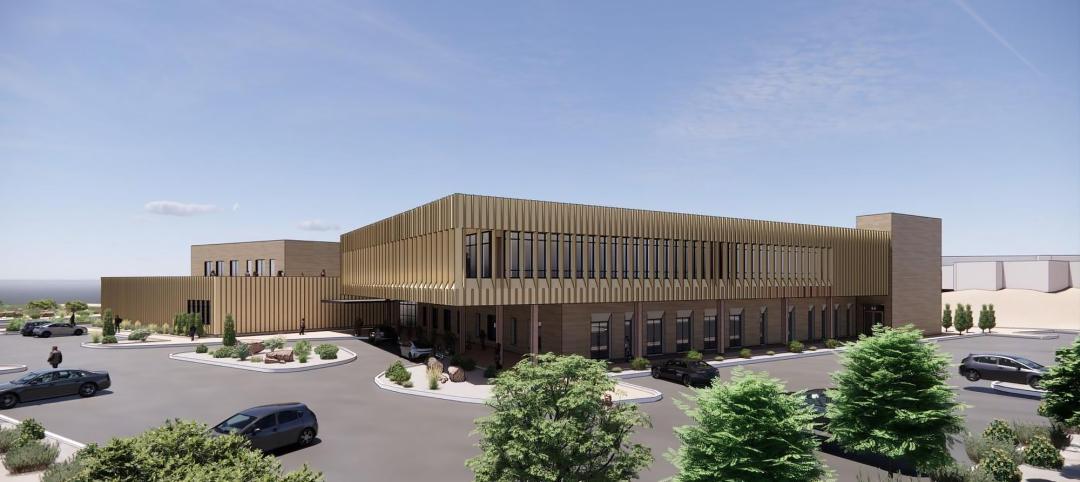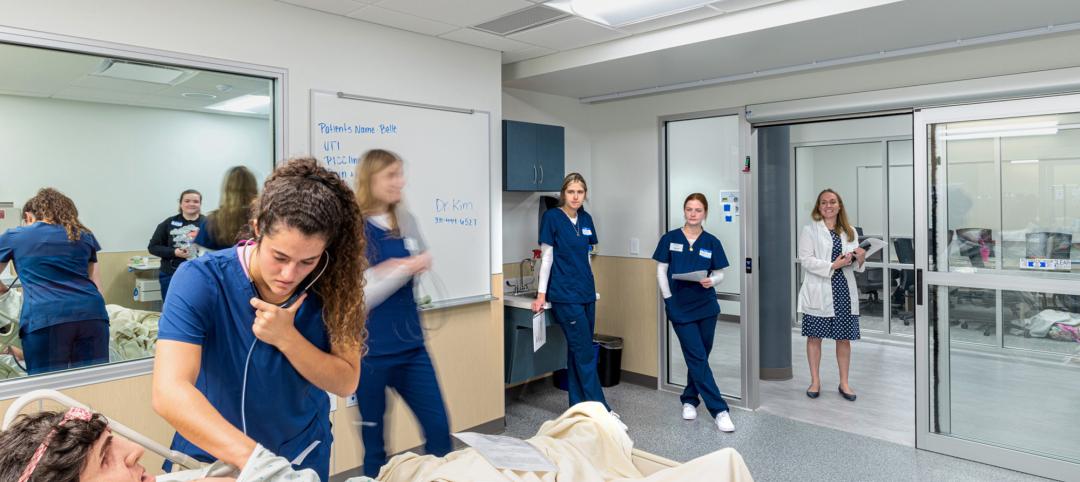Over the past few decades, numerous research studies have concluded that noise in hospitals can have a deleterious effect on patient care and recovery. “The first step in noise reduction in hospitals is awareness about the effect that noise has on patients and providers,” says Paul Barach, MD, Clinical Professor, Wayne State University, Detroit.
Barach cites studies that estimate average hospital noise at 70–80 decibels, or 20–30 db above World Health Organization recommended levels. Older hospitals have even worse acoustics. Barach also suggests that noise in general is an “abstraction” that even newer hospitals find difficult to define and mitigate.
Noise control is even more important now that the Affordable Care Act has mandated that reimbursement for hospital services be based, in part, on patient satisfaction surveys. These surveys have consistently given the lowest scores to hospital environments for sleep disruption. It’s little wonder, then, that hospitals are pursuing more quietude in their plans for new buildings, renovations and expansions, as well as in their personnel training.
“Acoustics is invisible until it’s a problem,” observes James Perry, Chief Technology Officer for the New York-based acoustical and A/V consultant Cerami & Associates. He emphasizes, too, that noise “is about behavior,” and often is generated “by activities [more] than building systems.”
Different rooms, different noises
Noise abatement strategies need to take into account that hospitals have many rooms with different noise characteristics, says Ben Davenny, PE, INCE, LEED AP EDAC, a Senior Acoustical Consultant with Acentech. Patient floors are usually organized around bustling nurses’ stations. MRI rooms are particularly sensitive to vibration through floors and walls. Operating rooms require 20 air exchanges per hour, creating their own unique din.
There are lobbies, waiting rooms, examination and emergency rooms where privacy is paramount. Many larger, regional hospitals have helipads: their chopper noise must be kept from entering the building.
Davenny points out that it is useful to consider the type of noise source. “There’s a false impression that a quieter environment is always a better one,” he says. “The trick is to take a different look at these noise sources and develop more efficient methods in reducing disturbance to patients.”
Medical technology has become a new noise source that has “overwhelmed” the hospital environment, says Joanne Solet, PhD, Assistant Clinical Professor of Medicine at Harvard Medical School. Solet was part of a team of researchers that conducted a three-day study in which the team subjected 12 healthy participants to 14 different sounds to determine which sounds were most likely to disrupt sleep.
The team’s findings, published in the Annals of Internal Medicine (June 2012), found that “electronic sounds” were more arousing than others. “If these noises bothered a dozen healthy people, you can bet they are bothering people who are patients,” says Solet.
Over the din, patients are heard
Noise reduction started showing up on hospitals’ radar screens in 2006, when the Centers for Medicare & Medicaid Services (CMS) implemented an ongoing national survey—known as the Hospital Consumer Assessment of Healthcare Providers and Systems, or HCAHCP—to measure customer satisfaction with hospital care. When the Affordable Care Act became law, it included a requirement that the survey results be used as one measure to calculate payments that CMS made to acute-care hospitals.
“The surveys let consumers weigh in, and with HCAHCP, hospitals can’t bury their issues,” says David Sykes, Chairman of the Acoustics Research Council.
From July 1, 2013 through June 30, 2014, the latest period tracked and posted by Medicare.gov, 62% of patients surveyed said their rooms were “always quiet at night,” with another 29% saying their rooms were “usually quiet.” Those scores were below patient ratings for 30 other criteria of their hospital stay, such as cleanliness and communications.
With one in three hospitals operating in the red, according to the American Hospital Association, patient satisfaction has become a make or break issue. The poorest-performing hospitals have 1% of their total annual reimbursements withheld by CMS; the highest-performing facilities get a 1% bonus. By 2017, those fines and bonuses will increase to 2%.
“Hospitals need to know how much quiet a patient needs to be able to sleep because they’re getting dinged by the government if their performance scores are low,” says Gary Madaras, PhD, Associate AIA, ASA, INCE, an Acoustics Specialist with Rockfon, which makes acoustic ceiling products. Solet adds that the government now bases its acceptance levels for patient readmission to hospitals in part on the facility’s past performance.
Healthcare systems are addressing this problem by getting more stakeholders involved in helping them improve patient satisfaction. HGA Architects and Affinity Health solicited input from former patients, family members, and caregivers during pre-design sessions for Affinity’s 25,000-sf Heart, Lung, and Vascular Center at St. Elizabeth Hospital, in Appleton, Wis. Those sessions included discussions about workflow, corridor circulation patterns, and patient privacy. The team also implemented a post-occupancy evaluation determine whether its evidence-based design principles were being achieved in areas that include noise levels.
For several years now, architects have been turning to the Facilities Guidelines Institute’s guidelines for product and design best practices that can help their clients tone down noise and vibration. “We provide the tools to build the better mousetrap,” says FGI CEO Douglas Erickson, FASHE, CHFM, HFDP, CHC.
Stanford Health Care, Palo Alto, Calif., is building an 824,000-sf, 368-bed hospital that is following many of the noise and vibration reduction guidelines laid out by the FGI, says George Tingwald, MD, AIA, ACHA, Director of Medical Planning, Facilities Design and Construction at Stanford Health.
Hospitals are also trying to get their employees to be more alert to the noise they produce. Bonny Slater, Senior Interior Designer-Health & Wellness in Gensler’s Washington, D.C., office, sees hospitals experimenting with “quiet times,” when corridor lights are dimmed to signal when noise volumes should be lowered.
Reactions to noise are subjective
Not everyone is convinced that design can alter staff behaviors to reduce hospital noise, especially when a lot of hospitals still don’t coordinate when clinical, food service, and cleaning staffs enter a patient’s room, says Kenneth Van Wyk, President of consultant Acoustics by Design. “There are no dashboards in hospitals,” says Sykes. Chris Kay, ACHE, Managing Principal-National Healthcare & Science Buildings Practice at Jacobs, is even less sanguine about behavioral modification, which he calls “the least effective method of reducing hospital noise.”
Patient surveys have certainly given hospitals more insight into where their services and facilities are falling short or excelling. Jean R. Elrick, MD, Senior Vice President of Administration at Massachusetts General Hospital, in Boston, gets patient narratives every Wednesday. She says she can tell which buildings and departments are performing best. Mass General’s 530,000-sf Lunder Building, which opened in 2011, was among a handful of hospital facilities that closely followed FGI’s 2010 revised guidelines. Elrick says Lunder’s patient scores have consistently risen, and Lunder has become the model the hospital would follow when it renovates or expands other buildings on its campus.
The 640,000-sf MaineGeneral Medical Alfond Center for Health, in Augusta, which opened in August 2013, is another replacement hospital that was built to FGI’s noise and vibration guidelines. As a result, its “always quiet at night” score improved to 76.5% over the period December 2013 through July 2014, from 61.5% over the period January through October 2013. The portion of patients who would recommend the hospital jumped to 76.8%, from 65.2%, according to Rick Albert, MaineGeneral’s Director of Plant Operations.
But patient scores don’t tell the whole story, mainly because surveys don’t identify which noises are causing the most distress. Since 2010, Rockfon’s Madaras has tracked patient scores of about 50 new hospitals. He has found that most new faciliies aren’t that much better than older ones. Those findings lead Madaras to believe that reactions to hospital noises can be individual and subjective.
Solet points out that a certain portion of the population is always going to be more sensitive to their surroundings. So, says Tingwell of Stanford Health Care, a hospital’s biggest dilemma, when devising a noise-reduction strategy, might be figuring out how to assuage patients’ perceptions, real or imagined, about noise.
Related Stories
Healthcare Facilities | Dec 7, 2023
New $650 million Baptist Health Care complex opens in Pensacola
Baptist Health Care’s new $650 million healthcare complex opened recently in Pensacola, Fla. Featuring a 10-story, 268-bed hospital, the project “represents the single-largest investment in the healthcare history of northwest Florida,” said Gresham Smith project executive Robert “Skip” Yauger, AIA, LEED AP. The 602,000 sf Baptist Hospital is equipped with a Level II trauma center that provides 61 exam rooms and three triage areas.
Engineers | Nov 27, 2023
Kimley-Horn eliminates the guesswork of electric vehicle charger site selection
Private businesses and governments can now choose their new electric vehicle (EV) charger locations with data-driven precision. Kimley-Horn, the national engineering, planning, and design consulting firm, today launched TREDLite EV, a cloud-based tool that helps organizations develop and optimize their EV charger deployment strategies based on the organization’s unique priorities.
Healthcare Facilities | Nov 3, 2023
The University of Chicago Medicine is building its city’s first freestanding cancer center with inpatient and outpatient services
The University of Chicago Medicine (UChicago Medicine) is building Chicago’s first freestanding cancer center with inpatient and outpatient services. Aiming to bridge longstanding health disparities on Chicago’s South Side, the $815 million project will consolidate care and about 200 team members currently spread across at least five buildings. The new facility, which broke ground in September, is expected to open to patients in spring 2027.
Sponsored | | Oct 17, 2023
The Evolution of Medical Facility Security
As the healthcare system grows, securing these facilities becomes ever more challenging. Increasingly, medical providers have multiple facilities within their networks, making traditional keying systems and credentialing impractical.
Healthcare Facilities | Oct 11, 2023
Leveraging land and light to enhance patient care
GBBN interior designer Kristin Greeley shares insights from the firm's latest project: a cancer center in Santa Fe, N.M.
Healthcare Facilities | Oct 9, 2023
Design solutions for mental health as a secondary diagnosis
Rachel Vedder, RA, LEED AP, Senior Architect, Design Collaborative, shares two design solutions for hospitals treating behavioral health patients.
Giants 400 | Oct 5, 2023
Top 115 Healthcare Construction Firms for 2023
Turner Construction, Brasfield & Gorrie, JE Dunn Construction, DPR Construction, and McCarthy Holdings top BD+C's ranking of the nation's largest healthcare sector contractors and construction management (CM) firms for 2023, as reported in Building Design+Construction's 2023 Giants 400 Report. Note: This ranking includes revenue related to all healthcare buildings work, including hospitals, medical office buildings, and outpatient facilities.
Giants 400 | Oct 5, 2023
Top 90 Healthcare Engineering Firms for 2023
Jacobs, WSP, IMEG, BR+A, and Affiliated Engineers head BD+C's ranking of the nation's largest healthcare sector engineering and engineering/architecture (EA) firms for 2023, as reported in Building Design+Construction's 2023 Giants 400 Report. Note: This ranking includes revenue related to all healthcare buildings work, including hospitals, medical office buildings, and outpatient facilities.
Giants 400 | Oct 5, 2023
Top 175 Healthcare Architecture Firms for 2023
HDR, HKS, CannonDesign, Stantec, and SmithGroup top BD+C's ranking of the nation's largest healthcare sector architecture and architecture/engineering (AE) firms for 2023, as reported in Building Design+Construction's 2023 Giants 400 Report. Note: This ranking includes revenue related to all healthcare buildings work, including hospitals, medical office buildings, and outpatient facilities.
Adaptive Reuse | Sep 19, 2023
Transforming shopping malls into 21st century neighborhoods
As we reimagine the antiquated shopping mall, Marc Asnis, AICP, Associate, Perkins&Will, details four first steps to consider.


